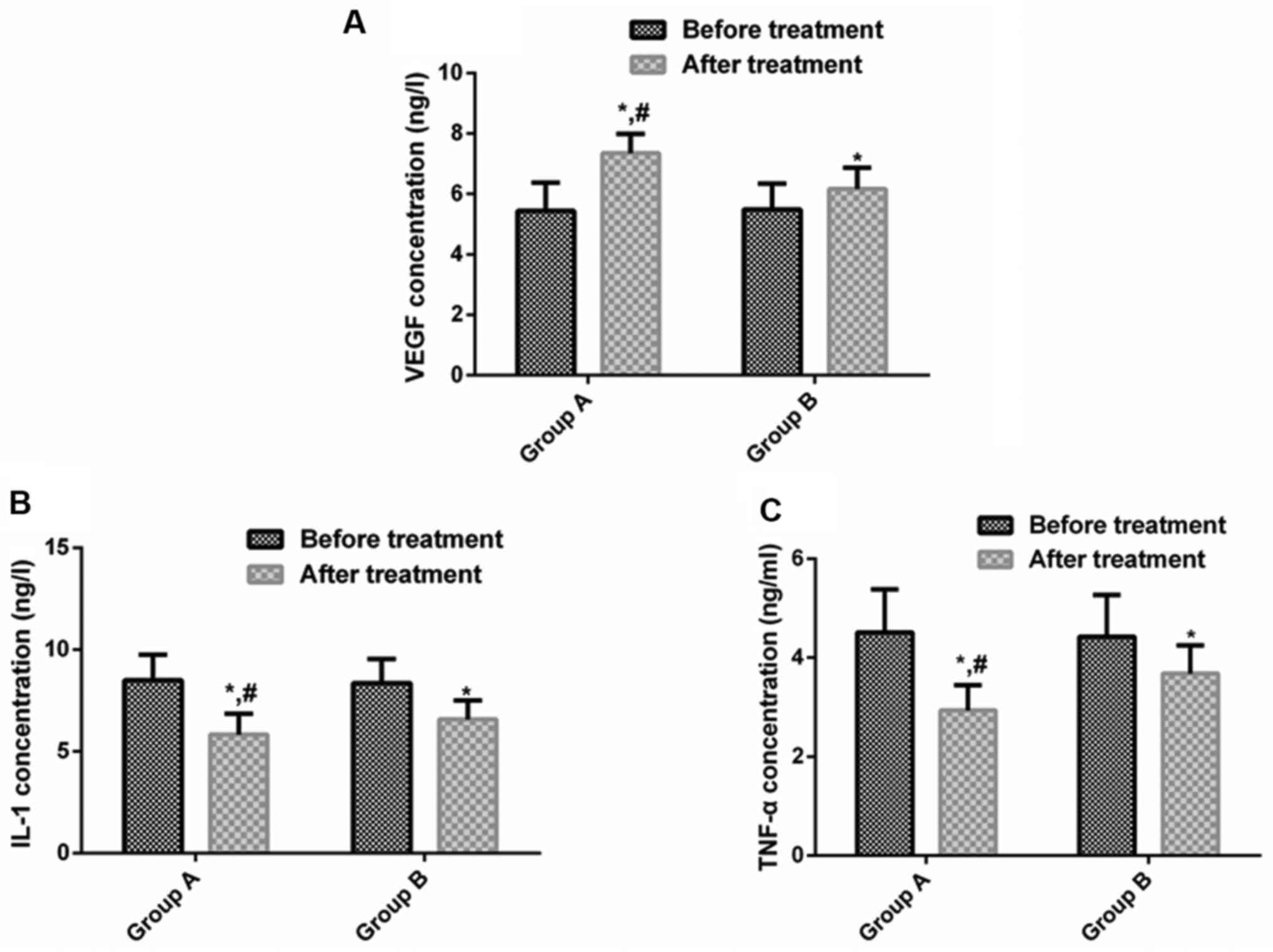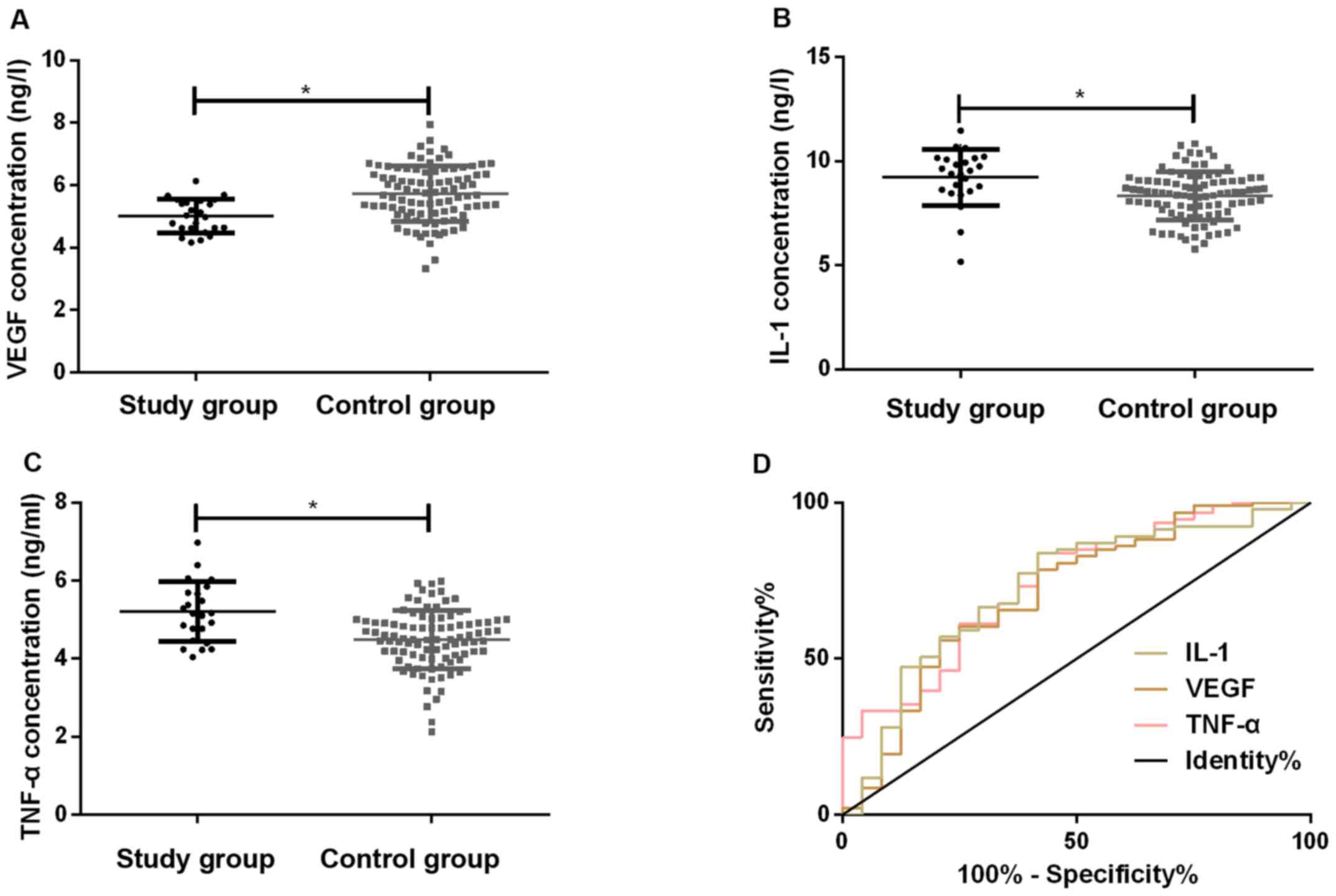|
1
|
Sun XL, Law BY, de Seabra Rodrigues Dias
IR, Mok SW, He YZ and Wong VK: Pathogenesis of thromboangiitis
obliterans: Gene polymorphism and immunoregulation of human
vascular endothelial cells. Atherosclerosis. 265:258–265.
2017.PubMed/NCBI View Article : Google Scholar
|
|
2
|
Rivera-Chavarría IJ and Brenes-Gutiérrez
JD: Thromboangiitis obliterans (Buerger's disease). Ann Med Surg
(Lond). 7:79–82. 2016.PubMed/NCBI View Article : Google Scholar
|
|
3
|
Neufang A, Vargas-Gomez C, Ewald P,
Vitolianos N, Coskun T, Abu-Salim N, Schmiedel R, von Flotow P and
Savvidis S: Very distal vein bypass in patients with
thromboangiitis obliterans. Vasa. 46:304–309. 2017.PubMed/NCBI View Article : Google Scholar
|
|
4
|
Klein-Weigel PF, Köning C, Härtwig A,
Krüger K, Gutsche-Petrak B, Dreusicke S, Thieme U, Enke-Melzer K,
Urbach B and Kron J: Immunoadsorption in Buerger's disease
(thromboangiitis obliterans): A promising therapeutic option:
Results of a consecutive patient cohort treated in clinical routine
care. Zentralbl Chir. 137:460–465. 2012.PubMed/NCBI View Article : Google Scholar : (In German).
|
|
5
|
Jiménez-Gallo D, Albarrán-Planelles C,
Arjona-Aguilera C, Blanco-Sánchez G, Rodríguez-Mateos ME and
Linares-Barrios M: Treatment of thromboangiitis obliterans
(Buerger's disease) with high-potency vasodilators. Dermatol Ther
(Heidelb). 28:135–139. 2015.PubMed/NCBI View Article : Google Scholar
|
|
6
|
Narváez J, García-Gómez C, Álvarez L,
Santo P, Aparicio M, Pascual M, López de Recalde M, Borrell H and
Nolla JM: Efficacy of bosentan in patients with refractory
thromboangiitis obliterans (Buerger disease): A case series and
review of the literature. Medicine (Baltimore).
95(e5511)2016.PubMed/NCBI View Article : Google Scholar
|
|
7
|
Sugimoto M and Komori K: Buerger's disease
(thromboangiitis obliterans). In: Systemic Vasculitides: Current
Status and Perspectives. Dammacco F (ed). Springer, Switzerland,
pp361-376, 2016.
|
|
8
|
Galyfos G, Kerasidis S, Kastrisios G,
Giannakakis S, Sachmpazidis I, Anastasiadou C, Geropapas G,
Papapetrou A, Papacharalampous G and Maltezos C: Conservative
treatment of patients with thromboangiitis obliterans or
cannabis-associated arteritis presenting with critical lower limb
ischaemia. Vasa. 46:471–475. 2017.PubMed/NCBI View Article : Google Scholar
|
|
9
|
Fazeli B, Dadgar Moghadam M and Niroumand
S: How to treat a patient with thromboangiitis obliterans: A
systematic review. Ann Vasc Surg. 49:219–228. 2018.PubMed/NCBI View Article : Google Scholar
|
|
10
|
Guo J, Guo L, Cui S, Tong Z, Dardik A and
Gu Y: Autologous bone marrow-derived mononuclear cell therapy in
Chinese patients with critical limb ischemia due to thromboangiitis
obliterans: 10-year results. Stem Cell Res Ther.
9(43)2018.PubMed/NCBI View Article : Google Scholar
|
|
11
|
Fazeli B and Rezaee SA: A review on
thromboangiitis obliterans pathophysiology: Thrombosis and
angiitis, which is to blame? Vascular. 19:141–153. 2011.PubMed/NCBI View Article : Google Scholar
|
|
12
|
Huang ZH, Kuo SY, Chiu YH, Chen HC and Lu
CC: Treatment of multiple refractory ankle ulcerations in
thromboangiitis obliterans: A case report. Medicine (Baltimore).
97(e10798)2018.PubMed/NCBI View Article : Google Scholar
|
|
13
|
Ferrara N and Adamis AP: Ten years of
anti-vascular endothelial growth factor therapy. Nat Rev Drug
Discov. 15:385–403. 2016.PubMed/NCBI View Article : Google Scholar
|
|
14
|
Akar AR, İnan MB and Baran Ç:
Thromboangiitis obliterans. Curr Treatm Opt Rheumatol. 2:178–195.
2016.
|
|
15
|
Fazeli B, Rafatpanah H, Ravari H, Farid
Hosseini R, Tavakol Afshari J, Hamidi Alamdari D, Valizadeh N,
Moheghi N and Rezaee SA: Sera of patients with thromboangiitis
obliterans activated cultured human umbilical vein endothelial
cells (HUVECs) and changed their adhesive properties. Int J Rheum
Dis. 17:106–112. 2014.PubMed/NCBI View Article : Google Scholar
|
|
16
|
Nosaka M, Ishida Y, Kimura A, Kuninaka Y,
Taruya A, Furuta M, Mukaida N and Kondo T: Contribution of the
TNF-α (tumor necrosis factor-α)-TNF-Rp55 (tumor necrosis factor
receptor p55) axis in the resolution of venous thrombus.
Arterioscler Thromb Vasc Biol. 38:2638–2650. 2018.PubMed/NCBI View Article : Google Scholar
|
|
17
|
Shapouri-Moghaddam A, Saeed Modaghegh MH,
Rahimi HR, Ehteshamfar SM and Tavakol Afshari J: Molecular
mechanisms regulating immune responses in thromboangiitis
obliterans: A comprehensive review. Iran J Basic Med Sci.
22:215–224. 2019.PubMed/NCBI View Article : Google Scholar
|
|
18
|
Olin JW: Thromboangiitis obliterans: 110
years old and little progress made. J Am Heart Assoc.
7(e011214)2018.PubMed/NCBI View Article : Google Scholar
|
|
19
|
Taniguchi T, Higuchi T, Tazaki J, Saito N
and Kimura T: Successful percutaneous transcatheter angioplasty of
radial artery in thromboangiitis obliterans (Buerger's disease).
JACC Cardiovasc Interv. 10:e205–e206. 2017.PubMed/NCBI View Article : Google Scholar
|
|
20
|
Kim DH, Ko YG, Ahn CM, Shin DH, Kim JS,
Kim BK, Choi D, Hong MK and Jang Y: Immediate and late outcomes of
endovascular therapy for lower extremity arteries in Buerger
disease. J Vasc Surg. 67:1769–1777. 2018.PubMed/NCBI View Article : Google Scholar
|
|
21
|
Narváez J, García-Gómez C, Álvarez L,
Santo P, Aparicio M, Pascual M, López de Recalde M, Borrell H and
Nolla JM: Efficacy of bosentan in patients with refractory
thromboangiitis obliterans (Buerger disease): A case series and
review of the literature. Medicine (Baltimore).
95(e5511)2016.PubMed/NCBI View Article : Google Scholar
|
|
22
|
Del Conde I and Peña C: Buerger disease
(thromboangiitis obliterans). Tech Vasc Interv Radiol. 17:234–240.
2014.PubMed/NCBI View Article : Google Scholar
|
|
23
|
Jun HJ: Endovascular revascularization for
the obstruction after patch angioplasty in Buerger's disease.
Korean J Thorac Cardiovasc Surg. 47:174–177. 2014.PubMed/NCBI View Article : Google Scholar
|
|
24
|
Dilege S, Aksoy M, Kayabali M, Genc FA,
Senturk M and Baktiroglu S: Vascular reconstruction in Buerger's
disease: Is it feasible? Surg Today. 32:1042–1047. 2002.PubMed/NCBI View Article : Google Scholar
|
|
25
|
Bozkurt AK, Köksal C, Demirbas MY, Erdoğan
A, Rahman A, Demirkiliç U, Ustünsoy H, Metin G, Yillik L, Onol H,
et al: Turkish Buerger's Disease Research Group: A randomized trial
of intravenous iloprost (a stable prostacyclin analogue) versus
lumbar sympathectomy in the management of Buerger's disease. Int
Angiol. 25:162–168. 2006.PubMed/NCBI
|
|
26
|
Fazeli B and Ravari H: Mechanisms of
thrombosis, available treatments and management challenges
presented by thromboangiitis obliterans. Curr Med Chem.
22:1992–2001. 2015.PubMed/NCBI View Article : Google Scholar
|
|
27
|
Campochiaro PA, Khanani A, Singer M, Patel
S, Boyer D, Dugel P, Kherani S, Withers B, Gambino L, Peters K, et
al: TIME-2 Study Group: Enhanced benefit in diabetic macular edema
from AKB-9778 Tie2 activation combined with vascular endothelial
growth factor suppression. Ophthalmology. 123:1722–1730.
2016.PubMed/NCBI View Article : Google Scholar
|
|
28
|
Palomo J, Dietrich D, Martin P, Palmer G
and Gabay C: The interleukin (IL)-1 cytokine family - Balance
between agonists and antagonists in inflammatory diseases.
Cytokine. 76:25–37. 2015.PubMed/NCBI View Article : Google Scholar
|
|
29
|
Jain A, Barrile R, van der Meer AD,
Mammoto A, Mammoto T, De Ceunynck K, Aisiku O, Otieno MA, Louden
CS, Hamilton GA, et al: Primary human lung alveolus-on-a-chip model
of intravascular thrombosis for assessment of therapeutics. Clin
Pharmacol Ther. 103:332–340. 2018.PubMed/NCBI View
Article : Google Scholar
|
|
30
|
Wan J, Yang Y, Ma ZH, Sun Y, Liu YQ, Li GJ
and Zhang GM: Autologous peripheral blood stem cell transplantation
to treat thromboangiitis obliterans: Preliminary results. Eur Rev
Med Pharmacol Sci. 20:509–513. 2016.PubMed/NCBI
|
|
31
|
Yong J, Zhang S, Gao Y, Guo W, Shi P and
Zhou Q: Effects of aspirin combined with cilostazol on
thromboangiitis obliterans in diabetic patients. Exp Ther Med.
16:5041–5046. 2018.PubMed/NCBI View Article : Google Scholar
|
|
32
|
Wu S, Sun X, Wu W, Shi D and Jiang T:
Effect of revascularization on IL-6 and TNF-α in patients with
thromboangiitis obliterans. Exp Ther Med. 15:3947–3951.
2018.PubMed/NCBI View Article : Google Scholar
|
|
33
|
Idei N, Soga J, Hata T, Fujii Y, Fujimura
N, Mikami S, Maruhashi T, Nishioka K, Hidaka T, Kihara Y, et al:
Autologous bone-marrow mononuclear cell implantation reduces
long-term major amputation risk in patients with critical limb
ischemia: A comparison of atherosclerotic peripheral arterial
disease and Buerger disease. Circ Cardiovasc Interv. 4:15–25.
2011.PubMed/NCBI View Article : Google Scholar
|
|
34
|
Sambandam MT, Boologapandian V and
Amalorpavanathan J: Limb salvage in critical limb ischaemia in
thromboangiitis obliterans patients - revascularisation - a study.
J Evol Med Dent Sci. 7:3679–3684. 2018.
|
|
35
|
Le Joncour A, Soudet S, Dupont A, Espitia
O, Koskas F, Cluzel P, Hatron PY, Emmerich J, Cacoub P,
Resche-Rigon M, et al: French Buerger's Network: Long-term outcome
and prognostic factors of complications in thromboangiitis
obliterans (Buerger's disease): A multicenter study of 224
patients. J Am Heart Assoc. 7(e010677)2018.PubMed/NCBI View Article : Google Scholar
|
|
36
|
Ye K, Shi H, Qin J, Yin M, Liu X1, Li W1,
Jiang M and Lu X: Outcomes of endovascular recanalization versus
autogenous venous bypass for thromboangiitis obliterans patients
with critical limb ischemia due to tibioperoneal arterial
occlusion. J Vasc Surg. 66:1133–1142.e1. 2017.PubMed/NCBI View Article : Google Scholar
|
















